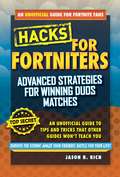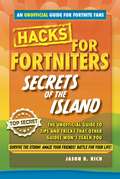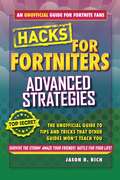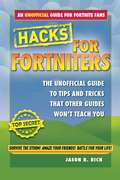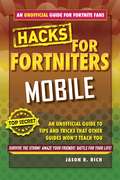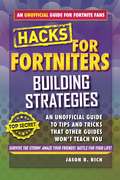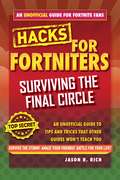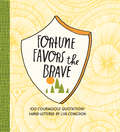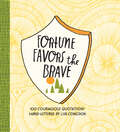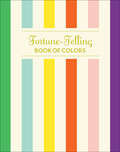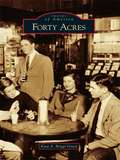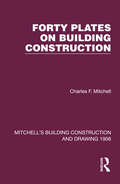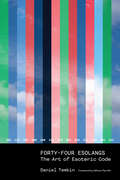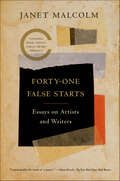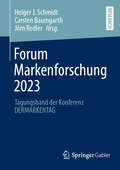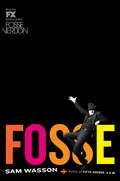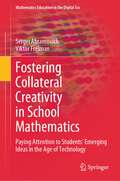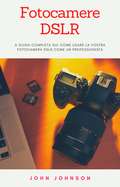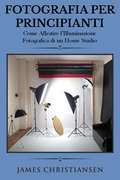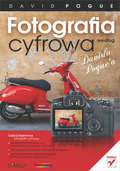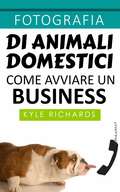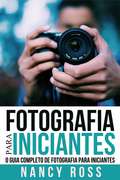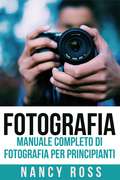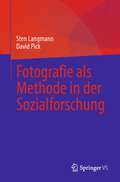- Table View
- List View
Fortnite Battle Royale Hacks: Advanced Strategies for Winning Duos Matches (Fortnite Battle Royale Hacks)
by Jason R. RichFortnite had than 10 million players 2 weeks after its release in September of 2017 and now has more than 40 million players worldwide. The game has 1.2 million likes on Facebook, 1.3 million followers on Instagram, and 1.74 million followers on Twitter.
Fortnite Battle Royale Hacks: An Unoffical Guide to Tips and Tricks That Other Guides Won't Teach You (Fortnite Battle Royale Hacks #1)
by Jason R. RichOver 270 screenshots with expert instructions! The ultimate Fortnite strategy guide with the tips and tricks you need!The best Fortnite book for kids eight and up, this full-color, unofficial strategy guide is a comprehensive guide to Fortnite: Battle Royale. This Fortnite guide book focuses heavily on what to expect throughout the island. Important locations on the Fortnite island are referred to as points of interest. Regardless of your experience or skill level playing the Fortnite: Battle Royale game, or which gaming platform you’re playing on, you’ll discover how the terrain dramatically varies based on where you are on the map. In addition to learning essential information about each point of interest, in this Fortnite Battle Royale book, you’ll learn:Proven tips and strategies for location-specific fightingHow and where to collect weapons, ammo, items, and lootHow and why you need to gather resources (wood, stone, and metal)How to build structures, ramps, bridges, and fortressesHow to safely explore and travel between points of interest on the islandHow to safely navigate around based on the location of the deadly storm - which makes an ever-growing portion of the island uninhabitable as each battle progresses Fortnite Battle Royale Hacks: Secrets of the Island is the complete Fortnite Battle Royale cheat book that showcases each point of interest using text and screenshots, so you can become intimately familiar with the important locations you’ll be visiting during the action-packed battles in the game. Fortnite Battle Royale Hacks: Secrets of the Island takes a geography-based approach to helping you become victorious, while also providing essential fighting, building, and exploring strategies that will prove extremely valuable during each battle. Because this Fortnite: Battle Royale tips book never offers the same play experience twice (since how the action unfolds depends heavily on the actions of the other 99 human players also on the island), this unofficial guide will teach you to adapt your offensive and defensive fighting strategies as needed to dramatically increase your chance of survival during each and every action-packed battle, regardless of where on the island a battle is taking place.
Fortnite Battle Royale Hacks: An Unoffical Guide to Tips and Tricks That Other Guides Won't Teach You (Fortnite Battle Royale Hacks #1)
by Jason R. RichThe Premier Fortnite Advanced Strategy Guide Book for the Most Popular Game in the World!The explosive, up-to-date Fortnite Battle Royale tips book for experienced players, this advanced Fortnite cheat book is the ultimate Fortnite book for kids and adults age 8 and up. Fortnite Battle Royale Hacks: Advanced Strategies focuses on more advanced game play strategies. This Fortnite strategy guide book for advanced Fortnite gamers will teach you: Advanced Fortnite strategies related to where to land on the Fortnite island to quickly find weapons and ammo! In-depth strategies for surviving the final circle, when the inhabitable map is very small and only a small handful of adversaries remain! The best uses for the individual Fortnite weapons in the Fortnite game! How to customize your Fortnite character’s appearance! How to customize your controls to achieve the best accuracy and speed in battles!If you manage to survive until the final circle, you need a new collection of Fortnite Battle Royale strategies. Fortnite Battle Royale Hacks: Advanced Strategies is the Fortnite strategy book that will help more experienced Fortnite game players like you prepare to reach the final circle, and then give you the expert Fortnite tips and tricks you need to become the last soldier standing at the end of each battle. For example, with this Fortnite Battle Royale book, you’ll learn how to quickly design and build an extremely tall and secure fortress.Fortnite Battle Royale Hacks: Advanced Strategies is the unauthorized guide book that will teach you how to advance on the final Fortnite enemies and defend against their attacks as they push toward your fortress for a final assault. This Fortnite guide book will also explain how to become a Fortnite pro and master the newest Fortnite gameplay modes that allow you to group with other players into pairs or teams of four in order to defeat all adversaries on the island.There is no second place in Fortnite!
Fortnite Battle Royale Hacks: An Unofficial Guide to Tips and Tricks That Other Guides Won't Teach You (Fortnite Battle Royale Hacks #1)
by Jason R. RichThe Ultimate Fortnite Guide… There is no second place!Fortnite Battle Royale Hacks is the Fortnite strategy book you’ve been waiting for! This Fortnite Battle Royale book focuses on the seven core elements of gameplay, giving you the TOP SECRET know-how to turn you into a Fortnite pro. This Fortnite strategy guide includes: Character Section, Customization, and Improvement Parachuting from the Battle Bus and Choosing an Ideal Landing Location Safe Exploration of the Island and Avoiding the Storm Finding and Gathering the Best Weapons, Ammo, and Loot Acquiring Resources (Wood, Brick, and Metal) Building Fortresses and Structures Surviving Combat to Become the Last Person StandingFor Playstation 4, Xbox One, Windows PC, and Mac, the Fortnite game transports gamers to an island that’s in the direct path of a strange and deadly storm. This free edition is a quest for survival?as one hundred players get trapped on the island, but only one will ultimately survive!Fortnite players must explore their surroundings to gather resources and then build protective shelters, plus locate weapons and loot (medical packs, potions, ammo, etc.)?all while attempting to defeat enemies in battle as the storm approaches, slowly making more and more of the island inhabitable. With so much at stake, you need the most up-to-date, comprehensive Fortnite book there is.This unofficial Fortnite Battle Royale strategy guide book for gamers ages 8 and up provides the tips and information needed to greatly improve your chances for survival. Fortnite Battle Royale Hacks is the ultimate unauthorized guide book that includes proven strategies for defeating opponents using weapons, tools, resources, and structures.Because the Fortnite Battle Royale game never offers the same play experience twice, this Fortnite Battle Royale tips book teaches you to adapt your offensive and defensive fighting strategies as needed to dramatically increase your chance of survival during each and every action-packed battle.This full-color, information-packed, 98-page Fortnite Battle Royale book for kids, teens, and adults is expertly designed to help first-time players greatly shorten the game’s learning curve and allows readers to abandon their “noob” status quickly, while dramatically improving their fighting, building, exploration, and survival skills. Experienced players will get an edge over their competitors with this legendary guide! With limited training activities and tutorials built into the game, Fortnite Battle Royale Hacks is the MUST READ game guide for beginner, intermediate, and advanced players… This is THE Fortnite cheat book for all the tips and tricks you won’t learn anywhere else.
Fortnite Battle Royale Hacks: An Unofficial Guide to Tips and Tricks That Other Guides Won't Teach You (Fortnite Battle Royale Hacks)
by Jason R. RichFortnite: Battle Royale Hacks: Mobileoffers a comprehensive introduction to playing this massively multiplayer, online-based game while on-the-go from a smartphone or tablet. For example, it focuses on customizing the game controls using the Customizable HUD (Head-Up Display) interface and discuss the pros and cons of using a Cellular Data Connection versus a Wi-Fi Internet connection when playing. Each section of this unofficial strategy guide covers a different aspect of the game play experience. The book contains hundreds of full-color screenshots taken using an iPhone and iPad, and potentially Android-based devices as well. Targeted to readers age 8 and up, Fortnite: Battle Royale Hacks for Mobile will be a full-color, unofficial strategy guide that will focus on: The intricacies of playing Fortnite: Battle Royale on a smartphone or tablet. How to download and install the game and set up an Epic Games account to start playing for free. How to customize the on-screen controls using the Customizable HUD that’s exclusive to the mobile version of the game. How to customize a character’s appearance. Getting acquainted with the game play modes. Tips and strategies for choosing the ideal landing location; exploration; building; gathering resources; finding and collecting loot; managing a character’s inventory; finding, choosing and using weapons; perfecting weapon aim; avoiding the storm; and winning matches. Because Fortnite: Battle Royale never offers the same play experience twice (since how the action unfolds depends heavily on the actions of the other 99 human players also on the island), this unofficial guide will teach players to adapt their offensive and defensive fighting strategies as needed to dramatically increase their chance of survival during each and every action-packed battle, regardless of where on the island a battle is taking place.
Fortnite Battle Royale Hacks: An Unofficial Guide to Tips and Tricks That Other Guides Won't Teach You (Fortnite Battle Royale Hacks)
by Jason R. RichFortnite Battle Royale Hacks: Building Strategies will demonstrate how to build a variety of customized structures, as well as offer fortress design ideas utilized by pro players. Step-by-step building instructions, along with full-color screenshots and strategies for choosing the right building materials and building locations, are provided within this invaluable resource. In addition to these building strategies, this full-color, unofficial strategy guide will also provide hundreds of tips and tricks for surviving and winning each match. To survive, a player must simultaneously handle several key tasks, including: Exploration of the Island Finding, Collecting, and Using Weapons Finding, Collecting, and Using Loot Items Gathering and Using Resources Engage in Combat Against Enemy Soldiers Avoid the Deadly Storm Building Structures and Fortresses Targeted to readers age 8 and up, this unofficial guide will provide a comprehensive overview of the Fortnite Battle Royale game, regardless of which gaming platform the reader is using. An emphasis, however, will be placed on teaching expert building strategies that can be used throughout each match. An entire section of the book will include End Game fortress building strategies that will appeal to beginner and expert players alike.
Fortnite Battle Royale Hacks: An Unofficial Guide to Tips and Tricks That Other Guides Won't Teach You (Fortnite Battle Royale Hacks)
by Jason R. RichIn addition to the Solo game play mode (which pits each gamer up against up to 99 others in a real-time battle), the Duos mode allows gamers to team up with one friend in a quest to defeat all other gamers during a match. Meanwhile, the Squads mode allows teams of four players to enter into a match and work together as they battle against up to 96 other gamers. The Duos and Squads game play modes are permanent features built into the game, and they’ve proven to be extremely popular, since Fortnite: Battle Royale is, for the most part, cross-platform compatible. Thus, someone experiencing the game on a PS4 can team up with a PC user, for example, to play against a random section of other gamers, in real-time. An Encyclopedia of Strategies for Fortniters: Duos and Squads Strategies will be the first book in this unofficial strategy guide series to offer in-depth coverage of Fortnite: Battle Royale’s team-oriented game play modes. Thus, this unofficial strategy guide will be chock full of proven strategies and game play tips designed to help teams achieve victory in the Fortnite: Battle Royale matches they participate in. This expanded (approximately 176-page) guide will include a comprehensive overview of the Fortnite: Battle Royale game, with a special focus on the game’s team-oriented game play modes. The full-color book will appeal to readers age 8 and up, regardless of which gaming platform they’re using. Throughout each match, gamers must: Focus on survival Avoid the deadly storm Explore the island Gather resources Build structures and fortresses Find, collect, and utilize weapons and ammunition Acquire and use loot items Engage in combat against enemy soldiers with the goal of becoming the last person alive at the end of the match When experiencing any of the team-oriented game play modes, cooperative gameplay (teamwork) and communication with team members become vital. An Encyclopedia of Duos and Squads Strategies will soon be an indispensable resource for gamers experiencing the Duos or Squads game play modes (or any of the other team-oriented game play modes added to Fortnite: Battle Royale on a temporary basis).
Fortress Power: Hostile Designs and the Politics of Spatial Control
by Derek S. DenmanA compelling treatise on the relationship between power and enclosureFortress Power presents a genealogy of fortification as a material and political technology intent on obstruction, tracing its implementation across battlefields, borders, and urban environments. Drawing on the influential work of philosophers Michel Foucault and Giorgio Agamben, Derek S. Denman places the fortress alongside the archetypes of the prison and the camp, citing them as paradigmatic of how space is transformed into a tool of domination and control. Focusing on the defensive architecture of bastion fortresses, urban design, and border landscapes, Fortress Power charts the rise of a form of governance grounded in hostility, extending the scope of its subject from a piece of military construction to a much broader political concept. Detailing how power manifests in everything from city centers to international boundaries, the book analyzes the logic of fortification as it moves through various contexts in the advancement of surveillance, exploitation, warfare, and political authority. Through a unique blend of architecture and design studies, political theory, international relations, geography, and migration studies, Denman outlines the disquieting legacy of the fortress to highlight its role in the formation of modern government and the enactment of violence. In an era marked by the increasing prevalence of authoritarian power and conflicting geopolitical boundaries, he presents an insightful investigation of the weaponization of the built environment.
Fortune Favors the Brave: 100 Courageous Quotations
by Lisa CongdonA treasure trove of inspiring quotations in the tradition of the bestselling Whatever You Are, Be a Good One, this new ebook from beloved author and artist Lisa Congdon gathers rousing wisdom from history's great minds on how to be bold, stay strong, and take courage. Congdon lends her signature style of brilliant hand lettering to sage advice on such subjects as perseverance ("If you fell down yesterday, stand up today"—H.G. Wells), authenticity ("What should I be but just what I am?"—Edna St. Vincent Millay), and confronting fear ("Not everything that is faced can be changed, but nothing can be changed until it is faced"—James Baldwin). Filled with uplifting reminders to seize the day, Fortune Favors the Brave demonstrates that when embarking on a new adventure, the right words of encouragement can be a priceless gift.
Fortune Favors the Brave: 100 Courageous Quotations
by Lisa CongdonHand-lettered inspiration from the beloved indie artist and bestselling author of Whatever You Are, Be a Good One.A treasure trove of inspiring quotations, this volume from beloved author and artist Lisa Congdon gathers rousing wisdom from history’s great minds on how to be bold, stay strong, and take courage. Congdon lends her signature style of brilliant hand lettering to sage advice on such subjects as perseverance (“If you fell down yesterday, stand up today” —H.G. Wells), authenticity (“What should I be but just what I am?” —Edna St. Vincent Millay), and confronting fear (“Not everything that is faced can be changed, but nothing can be changed until it is faced” —James Baldwin). Filled with uplifting reminders to seize the day, Fortune Favors the Brave demonstrates that when embarking on a new adventure, the right words of encouragement can be a priceless gift.Praise for Whatever You Are, Be a Good One“An impossibly charming compendium . . . The common thread underpinning these quotes . . . is Congdon’s own sensibility about what it means to live with kindness and integrity, to cherish beauty and the creative spirit, and ultimately to be a good human being.” —Brain Pickings“This beautifully hand-lettered book shares 100 inspirational quotations from great minds such as Oscar Wilde, George Eliot, and Walt Whitman. Revisit this colorful read whenever you need a pick-me-up—or a push—to get out there and make the most of your day.” —Real Simple
Fortune-Telling Book of Colors (Fortune-Telling)
by K.C. JonesLearn to decipher the meaning of color in the world around you and discover how to harness its power in your daily life.The latest addition to the bestselling Fortune-Telling series, this little book divines auspicious signs and offers whimsical insights into all things color. Those hoping to brighten their fortunes will learn the portents of chromatic combinations, the meaning behind color auras, and the astrology of various hues. Featuring an extensive color catalog with vibrantly illustrated interiors, this treasure makes a lovely gift for housewarmings, color enthusiasts, and anyone searching for a little extra luck in life.
Forty Acres (Images of America)
by Kara A. GreenForty Acres was developed into a neighborhood in the 19th century from a 40-acre parcel of farmland. Just as many other neighborhoods have ethnic associations, many Irish Wilmingtonians have their roots in Forty Acres. Some Forty Acres families stayed for generations, and the neighborhood was popular well into the 20th century. What makes Forty Acres different is its sense of community and the close-knit relationships developed between its residents. While it is admired for its historic charm, the neighborhood is an urban community made up of a mixed-use residential and commercial village within the city of Wilmington. Today Forty Acres continues to be a place where the word "neighbor" holds strength, value, and friendship.
Forty Plates on Building Construction: A Textbook on the Principles and Details of Modern Construction First Stage (Or Elementary Course) (Mitchell's Building Construction and Drawing #3)
by Charles F. MitchellOriginally published in 1891, this volume was a companion volume to the Elementary and Advanced volumes of Building Construction and Drawing. The exquisite technical drawings give a technical level of detail which is invaluable for the study of late 19th Century construction methods and materials and cover brickwork and masonry, carpentry, joinery, plumbing, roof and iron work.
Forty-Four Esolangs: The Art of Esoteric Code (Hardcopy)
by Daniel TemkinA riveting collection of one artist&’s many approaches to esolangs—esoteric programming languages—showcasing the form&’s limitless artistic potential.In Forty-Four Esolangs, Daniel Temkin challenges conventional definitions of language, code, and computer, showing the potential of esolangs—or esoteric programming languages—as pure idea art. The languages in this volume ask programmers to write code in the form of prayer to the Greek gods, or as a pattern of empty folders, or to type code in tandem with another programmer, each with one hand on the keyboard, their rhythm and synchrony signifying computer action. Temkin includes languages written over the past fifteen years, along with some designed especially for this book. Other pieces are left as prompts for the reader to simply consider or perhaps to implement on their own.Esolangs are a collaborative form. Each language is a complete world of thought, where esoprogrammers build on the work of esolangers to make new discoveries. The language Velato, for instance, asks programmers to write music as code; while the language creates constraints for the programmer, each programmer brings their own coding and musical sensibility to the language. Other pieces are pure poetic suggestion in the legacy of Yoko Ono&’s event scores. These ask the programmer to, for example, follow the paths of the clouds over a single day and construct a language in response that uses those movements as code. Just as Ben Vautier claimed everything is art, this book blurs the lines between computation and everything else.
Forty-One False Starts: Essays on Artists and Writers
by Janet MalcolmA National Book Critics Circle Finalist for CriticismA deeply Malcolmian volume on painters, photographers, writers, and critics.Janet Malcolm's In the Freud Archives and The Journalist and the Murderer, as well as her books about Sylvia Plath and Gertrude Stein, are canonical in the realm of nonfiction—as is the title essay of this collection, with its forty-one "false starts," or serial attempts to capture the essence of the painter David Salle, which becomes a dazzling portrait of an artist. Malcolm is "among the most intellectually provocative of authors," writes David Lehman in The Boston Globe, "able to turn epiphanies of perception into explosions of insight."Here, in Forty-one False Starts, Malcolm brings together essays published over the course of several decades (largely in The New Yorker and The New YorkReview of Books) that reflect her preoccupation with artists and their work. Her subjects are painters, photographers, writers, and critics. She explores Bloomsbury's obsessive desire to create things visual and literary; the "passionate collaborations" behind Edward Weston's nudes; and the character of the German art photographer Thomas Struth, who is "haunted by the Nazi past," yet whose photographs have "a lightness of spirit." In "The Woman Who Hated Women," Malcolm delves beneath the "onyx surface" of Edith Wharton's fiction, while in "Advanced Placement" she relishes the black comedy of the Gossip Girl novels of Cecily von Zeigesar. In "Salinger's Cigarettes," Malcolm writes that "the pettiness, vulgarity, banality, and vanity that few of us are free of, and thus can tolerate in others, are like ragweed for Salinger's helplessly uncontaminated heroes and heroines." "Over and over," as Ian Frazier writes in his introduction, "she has demonstrated that nonfiction—a book of reporting, an article in a magazine, something we see every day—can rise to the highest level of literature."One of Publishers Weekly's Best Nonfiction Books of 2013
Forum Markenforschung 2023: Tagungsband der Konferenz DERMARKENTAG
by Holger J. Schmidt Carsten Baumgarth Jörn RedlerDieser Sammelband präsentiert zentrale Forschungsbeiträge der Konferenz DERMARKENTAG 2023. Die alle zwei Jahre stattfindende Tagung führt Markenforscher und Markenpraktiker zusammen und greift jeweils aktuelle Impulse, Diskussionen und Forschungserkenntnisse zur Zukunft der Markenforschung auf.
Fosse
by Sam WassonFrom “a smart and savvy reporter,” a biography of the award-winning performer and director that “abounds with colorful firsthand tales” (Janet Maslin, New York Times).Now the FX limited series Fosse/Verdon starring Sam Rockwell and Michelle Williams with Lin-Manuel Miranda executive producing.The only person ever to win Oscar, Emmy, and Tony awards in the same year, Bob Fosse revolutionized nearly every facet of American entertainment. His signature style would influence generations of performing artists. Yet in spite of Fosse’s innumerable achievements—including Cabaret, Pippin, All That Jazz, and Chicago, one of the longest-running Broadway musicals ever—his offstage life was shadowed by deep wounds and insatiable appetites.To craft this richly detailed account, best-selling author Sam Wasson has drawn on a wealth of unpublished material and hundreds of sources: friends, enemies, lovers, and collaborators, many of them speaking publicly about Fosse for the first time. With propulsive energy and stylish prose, Fosse is the definitive biography of one of Broadway and Hollywood’s most complex and dynamic icons.An NPR Best Book of the Year“Fascinating.” —Wall Street Journal“Spellbinding.” —Entertainment Weekly“Impeccably researched.” —Vanity Fair‘‘Scintillating.’’ —Publishers Weekly, starred review“Powerfully told.’’ —Paul Hendrickson, author of Hemingway’s Boat: Everything He Loved in Life, and Lost“Highly recommended for theater or movie aficionados, aspiring performers, and fans of engrossing biography.’’ —Library Journal, starred review‘‘Lushly researched . . . moving and memorable. . . . Graceful prose creates a richly detailed and poignant portrait.’’ —Kirkus Reviews (starred review) “A pure joy to read, cover to cover; you read it not merely for Fosse’s story, but also for Wasson’s inventive way of telling it.” —Booklist, starred review
Fostering Collateral Creativity in School Mathematics: Paying Attention to Students’ Emerging Ideas in the Age of Technology (Mathematics Education in the Digital Era #23)
by Viktor Freiman Sergei AbramovichThis book explores the topic of using technology, both physical and digital, to motivate creative mathematical thinking among students who are not considered ‘mathematically advanced.’ The book reflects the authors’ experience of teaching mathematics to Canadian and American teacher candidates and supervising several field-based activities by the candidates. It consists of eight chapters and an Appendix which includes details of constructing computational learning environments.Specifically, the book demonstrates how the appropriate use of technology in the teaching of mathematics can create conditions for the emergence of what may be called ‘collateral creativity,’ a notion similar to Dewey’s notion of collateral learning. Just as collateral learning does not result from the immediate goal of the traditional curriculum, collateral creativity does not result from the immediate goal of traditional problem solving. Rather, mathematical creativity emerges as a collateral outcome of thinking afforded by the use of technology. Furthermore, collateral creativity is an educative outcome of one’s learning experience with pedagogy that motivates students to ask questions about computer-generated or tactile-derived information and assists them in finding answers to their own or the teacher’s questions. This book intends to provide guidance to teachers for fostering collateral creativity in their classrooms.
Fotocamere DSLR: a Guida Completa sul Come Usare la Vostra Fotocamera DSLR Come un Professionista
by John JohnsonUsate regolarmente una fotocamera reflex? Volete imparare come usare il vostro dispositivo come un professionista e risparmiare tempo? Compatibile con la maggior parte delle fotocamere DSLR. Se avete risposto di sì a queste domande, questo manuale fa per voi. Sapevate che la vostra fotocamera DSLR ha migliaia di funzioni, e che queste vi renderanno la vita più facile e vi faranno risparmiare tempo mentre scattata foto meravigliose? Ad ogni modo, dato che ci sono così tante funzioni segrete, può essere difficile sapere esattamente come usare al meglio il vostro dispositivo. Questa guida include: - Come iniziare. - Come muoversi. - Le possibilità del dispositivo. - Come risparmiare tempo. - Come fare meno fatica e raggiungere obbiettivi facilmente. - Imparerete come usare il vostro dispositivo come veri professionisti. - Identificare i problemi. - Fare foto stupende. + MOLTO ALTRO! Se volete imparare come usare il vostro dispositivo come dei veri professionisti, allora questa guida fa per voi. --> Scorrete fino all’inizio della pagina e cliccate “aggiungi al carrello” per comprarla subito Dichiarazione di limitazione di responsabilità: Questo autore e i(l) detentore(i) dei diritti non hanno pretese, promesse o danno garanzie riguardo l’accuratezza, completezza o adeguatezza dei contenuti di questo libro, e nega la responsabilità per errori e omissioni nello stesso contenuto.
Fotografia Per Principianti: Come Allestire l'Illuminiazione Fotografica di un Home Studio
by James ChristiansenDescrizione del libro Sei un fotografo principiante e non sai come allestire l’illuminazione del tuo studio? Vorresti sapere come realizzare il tuo kit di illuminazione fotografica? Ecco un eBook sulla fotografia per principianti che ti spiegherà esattamente come creare il tuo allestimento di luci in un home-studio. Quando si è fotografi esordienti è difficile sapere cosa acquistare! Tutti sanno che l’illuminazione può rovinare una fotografia oppure renderla straordinaria ma come organizzare il proprio home-studio? Questo libro risponderà alle tue domande. In questo libro di fotografia per principianti imparerai: 1.Come allestire il tuo studio in casa 2. Le diverse tipologie di configurazione delle luci e come scegliere la migliore per le tue fotografie 3.Come sistemare i vari componenti 4. Suggerimenti sui prodotti da utilizzare 5. Spunti e trucchi per realizzare un allestimento luminoso davvero fantastico Hai bisogno di altri motivi per acquistare questo libro? Eccone una straordinaria: donerò il 5% dei ricavi dalle vendite a Reading Is Fundamental, la più grande e autorevole associazione no-profit per l’Alfabetizzazione Infantile in America! Non esitare oltre per provare a realizzare l’allestimento d’illuminazione perfetto. Acquista OGGI questo libro sulla fotografia per principianti e impara come realizzare l’allestimento luci di un home-studio!
Fotografia cyfrowa wed?ug Davida Pogue'a
by David PogueOdkryj tajemnice fotografii cyfrowej Jak korzysta? z milionów opcji wspó?czesnych aparatów cyfrowych? Jak tworzy? profesjonalne artystyczne fotografie?Jak wykorzystywa? darmowe programy do katalogowania i edycji zdj???Dzi?ki wielkiej popularno?ci aparatów cyfrowych ka?dy mo?e by? dzi? fotografem i nie wymaga to ani wielkich nak?adów finansowych, ani szczególnej wiedzy. Je?li jednak chcesz, aby Twoje zdj?cia by?y naprawd? pi?kne, koniecznie powiniene? przeczyta? t? ksiš?k?. Wykorzystujšc porady zawarte w podr?czniku, sprawisz, ?e Twoje fotografie b?dš nie tylko oglšdane, ale i podziwiane. Krótko mówišc, zdob?dziesz umiej?tno?ci tworzenia i obróbki profesjonalnej fotografii artystycznej. Ksiš?ka "Fotografia cyfrowa wed?ug Davida Pogue'a" zawiera najwa?niejsze informacje na temat profesjonalnej fotografii, aparatów i akcesoriów fotograficznych, a tak?e szereg instrukcji na temat cyfrowej obróbki zdj??. Tym samym ukazuje ca?y cykl powstawania perfekcyjnej fotografii. Z tego podr?cznika dowiesz si?, w jaki sposób sprawnie i efektywnie pos?ugiwa? si? programami do edycji zdj?? oraz jak zarzšdza? fotografiami. Znajdziesz tu wskazówki dotyczšce artystycznej kompozycji obrazu czy o?wietlenia. Nauczysz si? retuszowa? fotografie, poprawia? ich kontrast, oblicza? rozdzielczo??, przygotowywa? do druku i zamieszczenia w Internecie. Kompozycja zdj?cia Akcesoria fotograficzneTryby na?wietlaniaOstro?? Wykorzystanie lampy b?yskowej Zdj?cia w ruchu Zdj?cia sceniczne i podwodne PortretyRetuszowanie i poprawianie kontrastuObliczanie rozdzielczo?ciZdj?cia elektroniczne Wykorzystaj nowoczesne technologie i twórz profesjonalne, artystyczne fotografie!
Fotografia di animali domestici: come avviare un business
by Kyle Richards Laura AlbiniNon è mai stato facile trovare successo e felicità in un mestiere che offre infinite possibilità di crescita e tanto divertimento. La fotografia di animali domestici è la risposta che stai cercando! Chi non vorrebbe avere le libertà artistiche della fotografia e il divertimento che fa bene al cuore derivato dal fatto di lavorare con i migliori amici di tutti, cioè gli animali? Immagina che sia il tuo lavoro quotidiano! "Fotografia di animali domestici: come avviare un business" è il tuo manuale per iniziare, per fare quello che ami e divertirti da matti! Le persone stravedono per i loro animali domestici! Chiedi a chiunque e ti dirà che i suoi animali domestici sono membri della famiglia, non bestie. Ogni famiglia vorrebbe avere belle foto dei suoi cari per mostrarle e conservarle. Non c'è momento migliore di questo per trovare un mestiere che ami e trarre vantaggio dallo scoppiettante mondo degli animali. "Fotografia di animali domestici: come avviare un business" ti guiderà lungo il cammino per trasformarti da amante di animali domestici in capo del tuo redditizio business fotografico in pochissimo tempo! Il processo è suddiviso in semplici passi creati in modo da essere adatti a tutti, a prescindere dall'esperienza in ambito commerciale. "Fotografia di animali domestici: come avviare un business" ti consente di avere tutto a portata di mano: la tua attività, i grandi guadagni, l'ambiente di lavoro rilassante e i clienti che ti adorano! Spezza la vecchia routine che ti sta logorando e segui il tuo cuore verso il successo. La più grande opportunità della tua vita sta aspettando di essere liberata dalle pagine di questo inestimabile libro.
Fotografia para Iniciantes: O Guia Completo de Fotografia para Iniciantes
by Livia Linhares Nancy RossDESCUBRA TUDO SOBRE O BÁSICO DE FOTOGRAFIA. Aqui vai uma prévia do que você irá aprender: como escolher a câmera certa, regras de composição, cor, iluminação, edição de fotos, níveis e camadas, efeito Orton, arrumar problemas comuns de suas fotos e muito, muito mais! Garanta já a sua cópia!
Fotografia: Manuale Completo Di Fotografia Per Principianti
by Nancy Ross Ilaria GhezziDISPONIBILE ANCHE IN VERSIONE TASCABILE E AUDIOLIBRO!!! SCOPRI I SEGRETI DELLA FOTOGRAFIA! Ecco un’anticipazione di cosa imparerai... SCEGLIERE LA MACCHINA FOTOGRAFICA GIUSTA REGOLE DI COMPOSIZIONE COLORE E LUCE EDITING FOTOGRAFICO LEVELING E LAYERS (LIVELLI) EFFETTO ORTON RISOLVERE I PROBLEMI PIÚ COMUNI E MOLTO ALTRO! Vuoi saperne di più? Fai in fretta! Solo per un periodo di tempo limitato potrai scaricare “Fotografia: Manuale Completo Di Fotografia Per Principianti" ad un prezzo scontato speciale. Scorri fino all’inizio della pagina e clicca sul tasto Compra. SCARICA LA TUA COPIA ADESSO!
Fotografie als Methode in der Sozialforschung
by Sten Langmann David PickDieses Buch konzentriert sich auf die Fotografie im Bereich der Sozialforschung. Es schafft eine umfassende Grundlage für die Fotografie als Methode der Sozialforschung und beschreibt verschiedene Techniken und Anwendungen der Fotoforschung. Das Buch bietet zudem reichhaltige Ansätze für die Forschungsfotografie, von der Vorbereitung und den ethischen Erwägungen, die vor dem Einsatz im Feld verstanden werden müssen, bis hin zur Datenerfassung, Analyse und Aufbereitung für die Veröffentlichung. Darüber hinaus werden künstlerische Gattungen der Fotografie vorgestellt, um den Lesern bei der Auswahl ihrer fotografischen Forschungsarbeit zu helfen und sie daran zu erinnern, dass sie beim Sammeln von Fotografien tatsächlich Kunst produzieren. Die ethischen Fragen bieten zudem neue Schwerpunkte für Leser zur Würde der Teilnehmer und weiter Überlegungen zur Anonymität oder auch Anerkennung, informierter Zustimmung, Forschung mit bedürftigen Gruppen, ungleichen Machtverhältnissen, und möglichen Interventionen. In einer Kombination aus Vorbereitung und Ethik wird hinterfragt, wie man am besten gute Fotos sammeln und aufnehmen kann, und es werden die praktischen Fragen der Stigmatisierung erörtert und Verständnis zur Unterstützung der Forscher im Feld eingeführt. Anschließend werden die verschiedenen fotoanalytischen Ansätze für Forscher erörtert und Beispiele für die Analyse von Fotos mit den verschiedenen Techniken gegeben. Abschließend bietet das Buch Leitlinien mit Beispielen für Forscher, die ihre Arbeit veröffentlichen möchten und wie dies ermöglicht werden kann.
